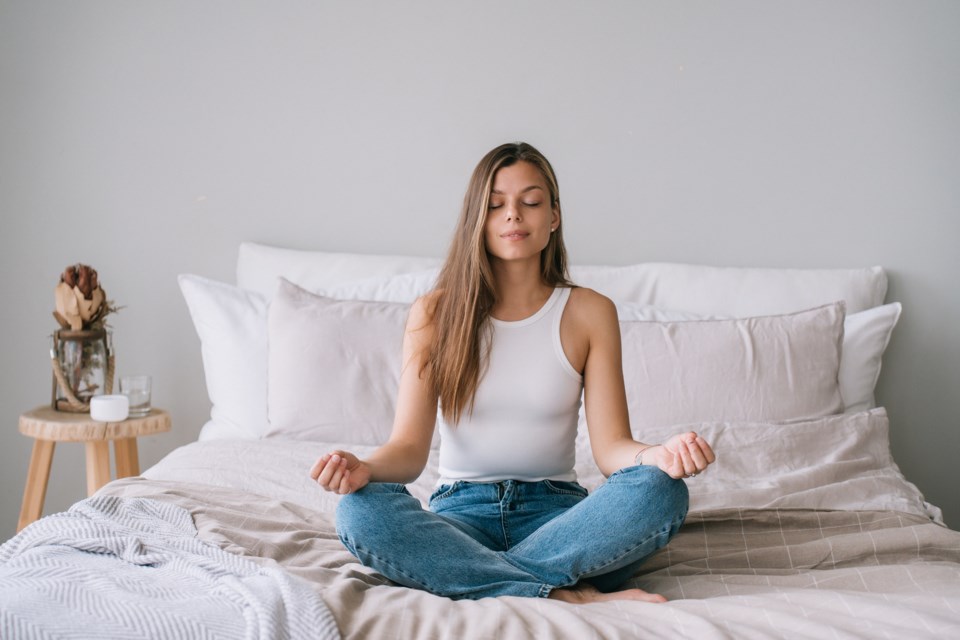Getting a good night’s sleep isn’t something any of us can afford to take for granted.
We all feel so much better after a deep, restorative sleep, but how it happened in the first place is often a mystery. We chalk up a particularly great rest to luck and hope we’ll have another one soon, crossing our fingers.
You don’t have to leave it all up to chance. By establishing a good bedtime routine and practicing the principles of sleep hygiene, you can have more and more nights of blissfully satisfying rest. The following tips can help.
Boost your activity levels during the day

If you’ve ever spent a day being uncharacteristically lazy, taking far fewer steps than normal and not elevating your heart rate as much as usual, you know how difficult it can be to get a good night’s sleep. You simply haven’t been active enough to earn a solid rest.
Getting regular exercise—and just moving around more often, being active—is key. The Canadian Society for Exercise Physiology sums it up perfectly: “Make your whole day matter. Move more. Reduce sedentary time. Sleep well.”
Their 24-hour movement guidelines offer clear direction on what a healthy 24 hours looks like for the average Canadian. Those aged 18-64 should aim for 7-9 hours of good quality sleep on a regular basis, while people 65+ should strive for 7-8 hours. If you can replace sedentary behaviour with additional physical activity and trade light physical activity for more moderate to vigorous physical activity (while preserving sufficient sleep), you’ll experience greater health benefits, they say.
Sunlight plays an important role in sleep hygiene as well. During the day, make sure you get some exposure to natural light.
Watch the caffeine

Caffeine is a stimulant found in tea, coffee, chocolate and certain flavourings and extracts. Some foods are also allowed to contain added caffeine, though these are regulated.
The recommended maximum daily intake for adults 18+ is 400 mg, according to Health Canada. For reference, the average 355 ml can of cola contains between 36 to 50 mg and the average cup of brewed coffee contains 135 mg.
Of course, not everyone is affected by caffeine in the same way: some feel its effects instantly and it seems to linger in the bloodstream, making sleep difficult, while others can enjoy a cup of coffee late at night and have no problems nodding off. Other side effects in addition to insomnia can result, including irritability, headaches and nervousness.
If you’re at all sensitive to caffeine, lower your intake or consider avoiding it altogether. If you’re not quite ready to give it up entirely, experiment with different cut-off times until you find the one that works for you. Many find that setting their caffeine cut-off to 2 pm works, while others only indulge in the mornings.
Set the scene
Believe it or not, the state of your bedroom matters and there are helpful changes you can make to your physical environment. Sleep experts recommend a clean and clutter-free space is best to set the scene for a good night’s sleep.
The Sleep Foundation suggests you make your bedroom comfortable and keep it distraction-free. People tend to fall and stay asleep easier in a cooler room too, but not so cold that you’re shivering and uncomfortable. Start at about 19 or 20°C and adjust accordingly.
Follow a relaxing pre-bedtime routine

There’s a reason why parents of young children stick to a predetermined bedtime routine every night: it works. Following the same series of steps each evening primes the body (and, perhaps most importantly, the mind) for sleep. For an adult, this could include changing into your pajamas, brushing your teeth and washing your face.
You’ll also want to leave yourself some time every night to wind down and quiet your mind. There are lots of things you can try, including listening to some soft music, doing some light stretching or relaxation exercises, or reading. Don’t allow yourself to feel pressured into falling asleep; the goal of a pre-bedtime routine is simply to make sleep feel more automatic. Instead, try focusing on relaxation. Many find meditation and mindfulness particularly helpful at bedtime.
Dimming the lights is also important. Bright lights can hinder the production of melatonin, a hormone the body creates to encourage sleep. And yes, this means unplugging from electronics. Leave yourself a 30-to-60-minute pre-bed buffer time that is completely free of devices. The mental stimulation caused by cell phones, tablets and laptops is hard to shut off and the blue light they generate may also decrease the production of melatonin.
Establish—and stick to—a sleep schedule

Wanting to sleep in on weekends to catch a few extra hours of rest is only natural. You want to make up for the nights you stayed up too late, scrolling on your phone or streaming the latest episode of your favourite show. Unfortunately, a lazy Sunday sleep-in is one of the worst things you can do for your sleep/wake cycle.
It’s important stick to a fixed wake-up time; a fluctuating schedule prevents you from getting into the rhythm of consistent sleep. Calculate your targeted bedtime based on your fixed wake-up time and prioritize sleep, doing your best to be ready for bed at that time every night.
If you have a hard time falling asleep, have frequent sleep disturbances or experience daytime sleepiness, chances are you have poor sleep hygiene. Start by moving your bedtime up, one hour at a time, until you land on a sleep schedule that works for you.
